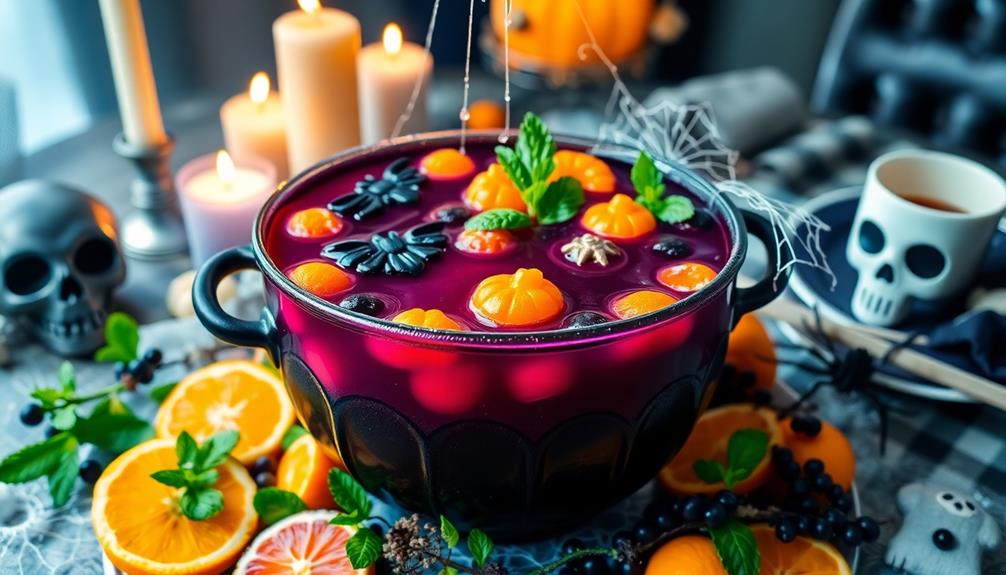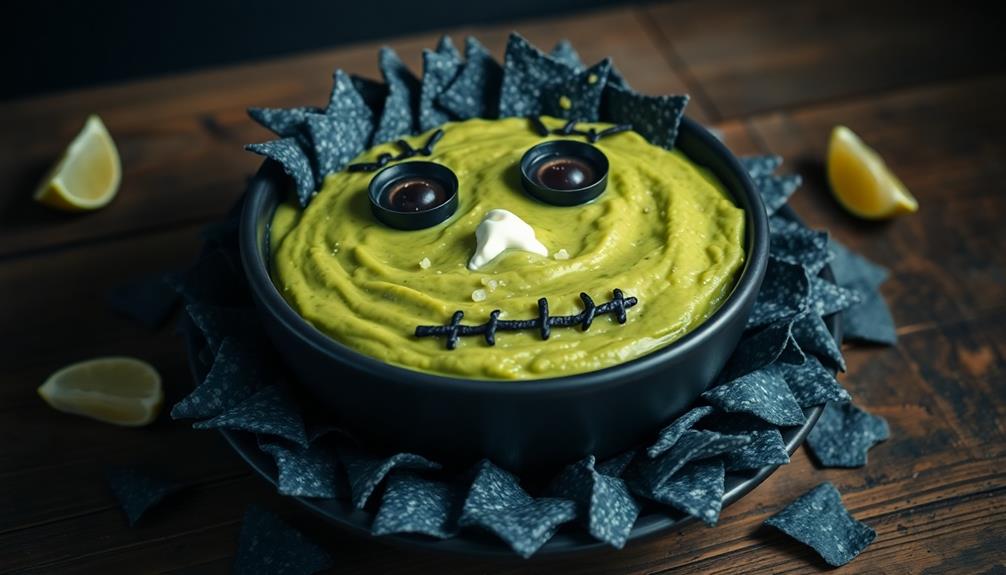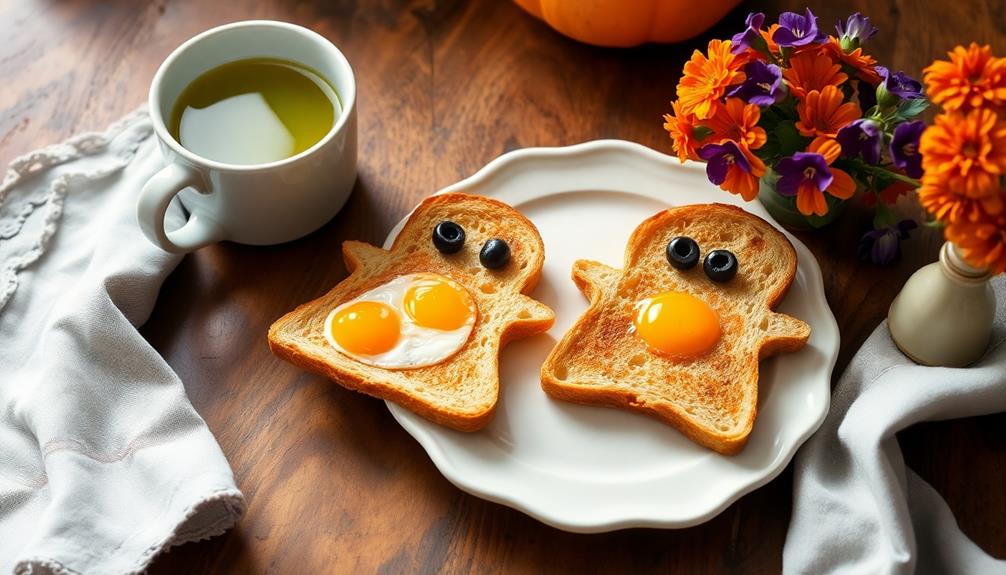To master gluten-free Halloween baking, start by choosing the right flours like almond, coconut, or special blends and experiment to see what works best. Use safe thickeners like xanthan gum or natural binders to improve your treats’ texture. Select flavorful sweeteners and extracts, and be sure to check labels carefully to avoid cross-contamination. Store your baked goods properly to keep them fresh and explore fun decoration ideas to make your treats festive. Keep going to uncover more tips!
Key Takeaways
- Use certified gluten-free flours and blends designed for baking to ensure safety and proper texture.
- Incorporate safe thickeners like xanthan gum or flaxseed to improve elasticity and stability.
- Prevent cross-contamination by dedicated utensils, tools, and careful label reading of ingredients.
- Store baked goods properly in airtight containers or freeze for extended freshness and safety.
- Get creative with Halloween-themed decorations using gluten-free ingredients and spooky edible accents.
Choosing the Right Flour and Mixes

When selecting gluten-free flours and mixes for Halloween baking, it’s important to understand that not all options behave the same way. Some gluten-free flour options, like almond or coconut flour, have unique textures and absorbency, which can affect your baked goods. To achieve consistent results, focus on mixing gluten-free blends designed specifically for baking. These blends often combine rice flour, tapioca starch, and potato starch to mimic traditional wheat flour’s structure and elasticity. Read labels carefully to find blends suited for cookies, cakes, or bread. Experimenting with different mixes helps you discover what works best for your recipes. Additionally, choosing authentic baking blends that are formulated for baked goods can greatly improve texture and flavor. Remember, selecting the right flour or blend is essential for creating delicious, gluten-free Halloween treats that look and taste fantastic.
Using Safe Thickeners and Binders
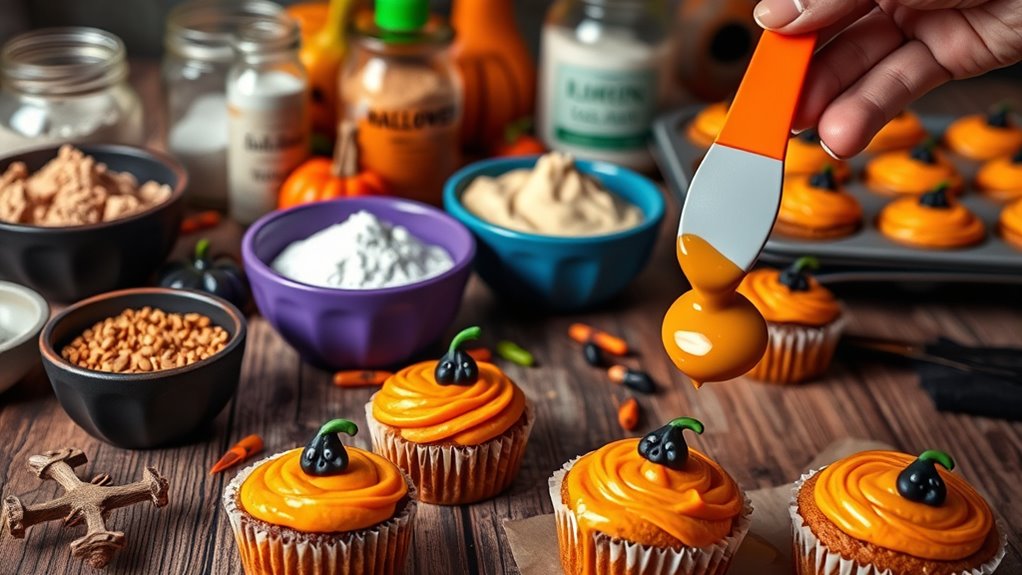
After choosing your gluten-free flours and mixes, the next step is to make certain your baked goods hold together and achieve the right texture. Gluten free thickeners and natural binders are essential for this. Common gluten free thickeners include xanthan gum and guar gum, which improve elasticity and structure. For natural binders, options like ground flaxseed, chia seeds, or applesauce work well, providing moisture and stability without gluten. Be sure to add these in proper amounts—too much can make baked goods gummy, while too little can cause crumbling. Incorporate the thickeners and binders gradually, mixing thoroughly to evenly distribute. Using the right combination helps your treats stay intact, have a pleasing texture, and look as festive as you want for Halloween. Additionally, understanding how gluten-free flours interact with these binders can optimize your baking results.
Selecting Gluten-Free Sweeteners and Flavors

When choosing sweeteners and flavors for your gluten-free Halloween treats, you have options like natural sweeteners such as honey or maple syrup, or artificial ones like sucralose. Consider how each impacts the taste and texture of your baked goods, and think about whether you’d prefer a more authentic flavor or a sugar-free alternative. Balancing flavor enhancement with dietary needs is key to creating delicious, festive treats. Additionally, understanding pinball machine weight can be useful if you plan to set up a themed candy station that includes vintage or decorative pinball machines as part of your Halloween decor.
Natural vs. Artificial Sweeteners
Choosing the right sweetener is essential for creating delicious gluten-free Halloween treats, and understanding the differences between natural and artificial options can help you make informed decisions. Natural sweeteners, like honey or maple syrup, add depth and subtle flavors, while artificial sweeteners provide sweetness with fewer calories. Here’s a comparison:
| Natural Sweeteners | Artificial Sweeteners |
|---|---|
| Derived from plants | Man-made chemicals |
| Rich in flavor | Usually flavorless |
| Contains nutrients | No nutrients |
| Can affect blood sugar | Often calorie-free |
Selecting the right type depends on your recipe and dietary goals. Both options have their place, so choose based on taste, health considerations, and how the sweetener interacts with your ingredients. Incorporating water properties can also influence the texture and moisture of your baked goods.
Flavor Enhancer Options
Selecting the right gluten-free sweeteners and flavors can elevate your Halloween treats by adding depth and intrigue. Natural extracts like vanilla, almond, or peppermint can enhance the overall flavor profile without overpowering the dessert. Spice blends, such as cinnamon, nutmeg, and pumpkin pie spice, bring warmth and seasonal flair that complement various baked goods. When choosing natural extracts, opt for pure, high-quality options to guarantee authentic taste and avoid artificial additives. Incorporate spice blends thoughtfully—start with small amounts, then adjust to taste, balancing sweetness and spice. These flavor enhancers not only boost the sensory experience but also keep your treats gluten-free and safe for everyone to enjoy. Experimenting with different combinations can help you craft uniquely delicious Halloween confections. Additionally, understanding the digital revolution in food development can inspire innovative flavor pairings and presentation styles that captivate your guests.
Reading Labels and Avoiding Cross-Contamination
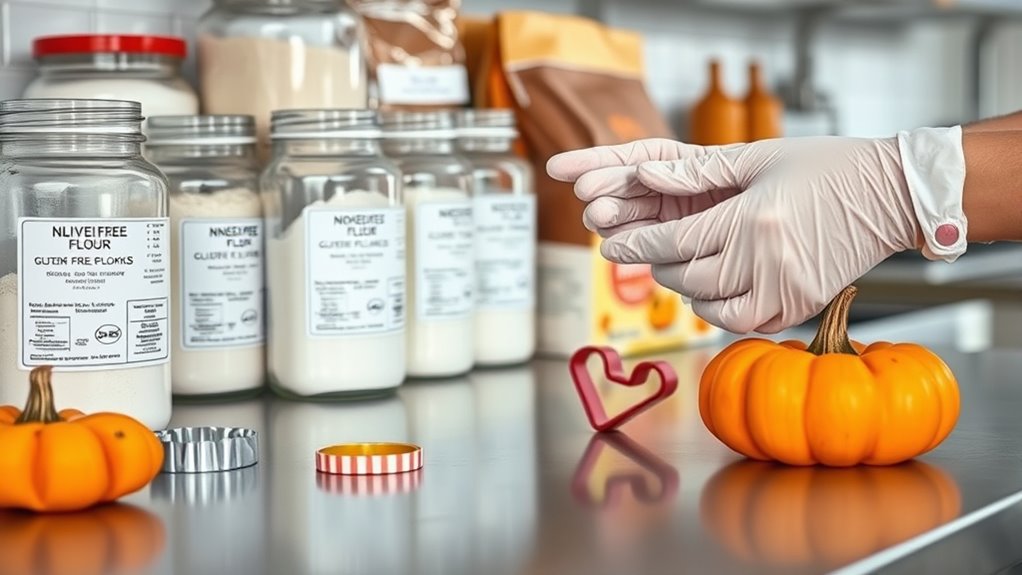
Always read ingredient labels carefully to spot any gluten-containing ingredients. Be alert for hidden gluten sources like malt or modified food starch, which can sneak into many products. To prevent cross-contamination, keep gluten-free items separate and clean your workspace thoroughly before baking. Using sustainable ingredients can also help support eco-friendly practices even in baking.
Reading Ingredient Labels Carefully
To guarantee your treats are truly gluten-free, it’s essential to read ingredient labels carefully. Start by checking the label ingredients for any mention of gluten sources like wheat, barley, or rye. Be wary of ambiguous terms such as “malt” or “natural flavors,” which can hide gluten. Here are key steps to follow:
- Scan for explicit gluten sources on the label ingredients list.
- Look for gluten-free certification symbols.
- Read ingredient lists even on products labeled “gluten-free,” as cross-contamination can occur.
- Avoid products with vague or questionable ingredients that might contain hidden gluten.
- Remember that gluten-free labels are helpful but not foolproof; always verify ingredients to ensure safety.
Identifying Hidden Gluten Sources
Even if a product is labeled gluten-free, hidden gluten can still lurk in unexpected ingredients or processing practices. Always read ingredient labels carefully, looking out for terms like malt, modified food starch, or natural flavoring, which can contain gluten. When planning your Halloween party, choose trusted brands and avoid products with ambiguous labels. This is especially important when selecting gluten-free snack ideas, as cross-contact during manufacturing can introduce gluten even if it’s not listed. Be cautious with candies and pre-packaged treats, and verify certifications if possible. Keep an eye on shared equipment or processing facilities, since cross-contamination can occur without visible signs. Ensuring proper product testing methods can help confirm that treats are genuinely gluten-free and safe for everyone enjoying your Halloween festivities. Staying vigilant helps ensure your treats are genuinely gluten-free and safe for everyone enjoying your Halloween festivities.
Preventing Cross-Contamination
Reading labels carefully is essential to prevent cross-contamination and guarantee your treats are truly gluten-free. Always check ingredient lists for hidden gluten sources and look for gluten-free certification. To maintain kitchen sanitation, designate separate equipment and utensils specifically for gluten-free baking. Here are key steps to avoid cross-contamination:
- Use clearly labeled, dedicated baking tools and storage containers.
- Regularly sanitize work surfaces and equipment to eliminate gluten residues.
- Keep gluten-containing ingredients separate from gluten-free ingredients at all times.
- Store gluten-free ingredients in sealed, dedicated containers away from potential contamination sources.
- Being aware of gluten-free product labels helps ensure safe ingredients in your baking.
Tips for Storing and Preserving Freshness
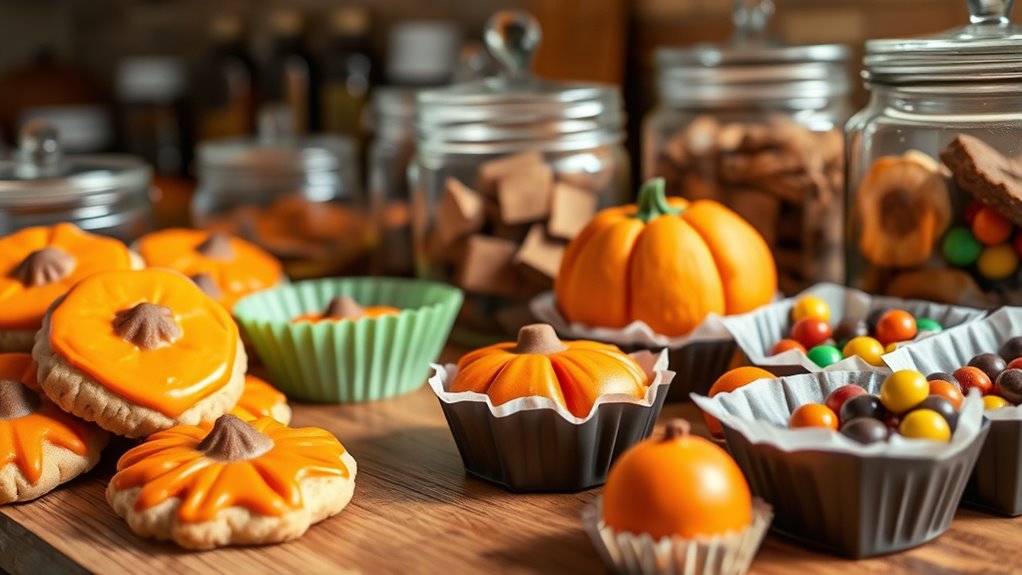
Wondering how to keep your gluten-free Halloween treats fresh longer? Proper storage is key to maintaining their flavor and texture for your Halloween party planning. Store baked goods in airtight containers at room temperature if they’ll be eaten within a few days. For longer storage, consider freezing treats—wrap them tightly in plastic wrap and place in a freezer-safe bag. When using seasonal ingredient substitutions, label your treats clearly to avoid confusion. Keep moisture away from your baked goods to prevent sogginess, especially if they contain fresh fruit or dairy. Also, consider the environment: store chocolates and candies in a cool, dry place away from direct sunlight. With these tips, your gluten-free goodies stay delicious, fresh, and ready to impress your guests. To ensure your treats stay safe during storage, make sure to follow safety checklists and proper handling guidelines.
Creative Gluten-Free Halloween Decoration Ideas

Transforming your space into a spooky, inviting Halloween scene doesn’t require traditional decorations—get creative with gluten-free-themed accents that add a fun, edible twist. Start by placing colorful pumpkin-shaped cookies on your dessert table to serve as festive treats and decorations. Add spooky cupcake toppers featuring ghosts, bats, or spiders to turn simple cupcakes into creepy art. Hang printable gluten-free banners with eerie messages for a haunting atmosphere. Incorporate themed elements like mini pumpkins or gourds made from gluten-free ingredients as centerpieces. Use glow-in-the-dark accents or edible glitter to enhance the spooky vibe. Incorporating specialized ingredients such as gluten-free flours can make your baked goods safer for everyone while still being festive. These ideas make your celebration unique, tasty, and visually enthralling without sacrificing safety or creativity.
Frequently Asked Questions
Are All Gluten-Free Flours Suitable for Baking Cakes?
Not all gluten-free flour types are suitable for baking cakes, as their baking performance varies. For light, fluffy cakes, you should choose options like almond flour, rice flour, or a gluten-free all-purpose blend designed for baking. These flours provide better structure and moisture retention. Avoid using just one type of gluten-free flour, as it can lead to dense or crumbly results. Combining different flours enhances the texture and taste of your cakes.
Can I Substitute Gluten-Free Mixes in Traditional Recipes?
Absolutely, you can turn traditional recipes into gluten-free wonders! Just remember, gluten-free ingredient swaps are your secret weapon, and baking substitution tips are your best friends here. Don’t expect perfect results every time—sometimes it’s like baking with a wild card. Experiment boldly, adjust liquids, and add a touch more binding agents if needed. With patience and creativity, your gluten-free mixes will transform your classic treats into Halloween masterpieces!
What Are Common Hidden Sources of Gluten in Baking Ingredients?
You should watch out for hidden gluten sources like additives, flavorings, and cross contamination during processing. Gluten cross contamination can occur if utensils or surfaces aren’t thoroughly cleaned, so always double-check labels. Common hidden gluten sources include soy sauce, malt, and certain thickeners. To keep your baking safe, read labels carefully, use dedicated tools, and buy certified gluten-free ingredients to avoid unintended gluten exposure.
How Do I Prevent Cross-Contamination in a Shared Kitchen?
Imagine your kitchen as a fortress, keeping gluten away. To prevent cross-contamination, always wear gloves when handling gluten-free ingredients and switch them between tasks. Use separate utensils, cutting boards, and mixing bowls for gluten-free baking. Clean surfaces thoroughly with soap and water. Label ingredients clearly and store them separately. These steps create a barrier, ensuring your Halloween treats stay safe and gluten-free, delighting everyone.
Are Gluten-Free Baked Goods Suitable for Freezing Long-Term Storage?
Yes, gluten-free baked goods are suitable for long-term freezing. To keep them fresh, follow freezing tips like wrapping items tightly in plastic wrap or using airtight storage containers to prevent freezer burn. Label your containers with dates to keep track of storage time. When you’re ready to enjoy your treats, thaw them at room temperature or in the fridge for the best texture and flavor.
Conclusion
By mastering these gluten-free Halloween baking basics, you can create spooky treats everyone will enjoy. For example, imagine making a batch of gluten-free monster cupcakes using safe flours, natural sweeteners, and creative decorations. With careful reading of labels and proper storage, your baked goods stay fresh and safe. So, get creative, stay mindful of ingredients, and make this Halloween a delicious, inclusive celebration for all your guests!



